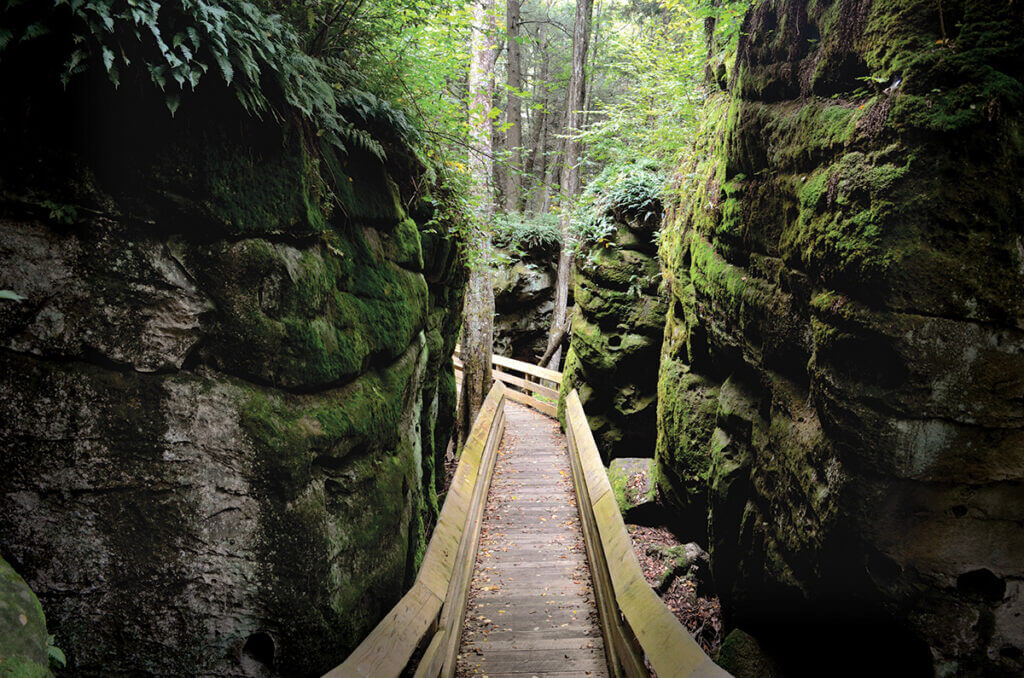This striking park seven miles from Hillsboro offers a serene retreat for visitors.
This story was originally published in the May 2015 issue of Wonderful West Virginia.
written by Shawnee Moran
photographed by Nikki Bowman Mills
Peaceful silence—that’s one of the first things you notice as you walk beneath the canopy of ancient hemlock trees and disappear into the labyrinth of towering rock formations at Beartown State Park. Sunlight trickles down from the treetops to the large ferns, lichen, and moss that carpet the ground, creating an otherworldly aura. “It’s a unique place with natural rock formations, cliffs, and crevasses—all these fantastic shapes of the rocks really stir people’s imagination,” says Mike Smith, Beartown State Park superintendent. “The softer layers underneath the sandstone have been weathered away by wind, rain, and vegetation at the edge of the mountain, opening up a 30-foot crevasse you can wander around in like a big maze. It’s a special place.”
Although Beartown’s rock formations, composed of Droop sandstone, are more than 300 million years old, the park has only been in existence for 45 years. When Huntington native Ronald Keith Neal was a boy, he loved to explore the area’s rocks. After he served and lost his life in the Vietnam War at 21 years old, his mother, Mrs. Edwin Polan, and The Nature Conservancy purchased the land in his memory. Her wish was for people to enjoy the land as her son did, and her dream came to fruition—on any given day Beartown welcomes children on school trips, family groups, bus tours, senior citizens, and individuals marveling at the beauty of the park.
The colossal cliffs and caves throughout the area are how the park got its name—these caves are ideal winter dens for black bears. “One year we kept the gate closed into April because there was a female den 50 feet way from the gate. When West Virginia Division of Natural Resources biologists arrived to put a radio collar on she was gone,” Smith says. “We do see them pretty often by the gate, road, and parking lot, but they generally aren’t a problem at all. It’s in their nature to leave when they see people.” Don’t worry—you aren’t likely to see a bear when visiting the park. Smith says since Beartown installed bear-proofed garbage cans last year they have seen a decrease in sightings.
Beartown State Park has also seen a decrease in hemlock growth. The hemlock woolly adelgid, an insect originating from Japan, has troubled hemlock trees throughout the east, including trees at Beartown. Although these soft-bodied insects are tiny— ¹â„ ³ ² of an inch to be exact—they can cause devastating damage to hemlocks. The decline of the tree can occur as early as four years after the moment of infestation. “Since it was first discovered 10 years ago we have treated the trees by various means. We have released beetles near the trees, which is the natural predator of the adelgid,” Smith says. He says a chemical treatment injected into the trees or into the soil around them has been the most effective method for combating the adelgid. “It has not completely devastated the hemlock forest as we thought it would because we caught it early and have been actively treating it. It’s not as bad here as in some places,” he says. When Smith first started at Beartown he noted the canopy was much thicker, and the trees produced a deep, dark shade. Now most of the trees have thinned out so sunshine reaches the floor of the park, and vegetation such as ferns, grasses, and birch, have been able to grow
Visitors can enjoy this green vegetation and the unusual rock formations at Beartown State Park at no cost. It is a day-use park, meaning the gates are only open from 7 a.m. until dusk. One of the few developments at Beartown is a half-mile loop boardwalk, a non-invasive addition that weaves between the towering rocks throughout the 107-acre state park. The boardwalk is a way to help preserve the ecology and give visitors easy access within the park.
Rock formations in the park often collect ice and snow during winter and they remain until mid- or late summer. Since he first started working at Beartown, one of Smith’s favorite traditions is to see if he can find any ice remaining in the woods on the Fourth of July. He says locals once used this ice during the summer to make ice cream for the celebration.
To this day Smith says locals have an overwhelming amount of pride for this park, and he has heard on multiple occasions this is one of the first places in the area locals bring visitors. In addition to Beartown State Park there are several popular nearby attractions in Pocahontas County, including the birth place of Pearl S. Buck, falls of Hills Creek, Cass Scenic Railroad State Park, Droop Mountain Battlefield State Park, the National Radio Astronomy Observatory, and Watoga State Park. “A lot of people traveling to Cass or to the National Radio Astronomy Observatory will stop by Beartown,” Smith says.
Smith encourages anyone visiting nearby attractions to spend a part of the day at Beartown State Park. After nearly 30 years at Beartown, he says he still finds little wonders around the park. “I open and close the park and, as a result, I have spent a considerable amount of time at Beartown. It’s a renewing experience to walk around the rocks. I just love it,” he says. “It’s a fun place to go. People love the rocks and can’t help but use their imagination. It’s a nice, calm place people love dearly—a real treasure, beartownstatepark.com.

